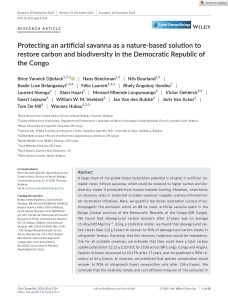
Djiofack B. Y., Beeckman H., Bourland N., Belanganayi B. L., Laurent F., Ilondea B. A., Nsenga L., Huart A., Longwwango M. M., Deklerck V., Lejeune G., Verbiest W. W. M., Van den Bulcke J., Van Acker J., De Mil T., Hubau W. [2024 ] Protecting an artificial savanna as a nature-based solution to restore carbon and biodiversity in the Democratic Republic of the Congo. Global Change Biology 30 – e17154.
Abstract :
A large share of the global forest restoration potential is situated in artificial ‘unstable’ mesic African savannas, which could be restored to higher carbon and biodiversity states if protected from human-induced burning. However, uncertainty on recovery rates in protected unstable savannas impedes science-informed forest restoration initiatives. Here, we quantify the forest restoration success of anthropogenic fire exclusion within an 88-ha mesic artificial savanna patch in the Kongo Central province of the Democratic Republic of the Congo (DR Congo). We found that aboveground carbon recovery after 17 years was on average 11.40 ± 0.85 Mg C ha−1. Using a statistical model, we found that aboveground carbon stocks take 112 ± 3 years to recover to 90% of aboveground carbon stocks in old-growth forests. Assuming that this recovery trajectory would be representative for all unstable savannas, we estimate that they could have a total carbon uptake potential of 12.13 ± 2.25 Gt C by 2100 across DR Congo, Congo and Angola. Species richness recovered to 33.17% after 17 years, and we predicted a 90% recovery at 54 ± 2 years. In contrast, we predicted that species composition would recover to 90% of old-growth forest composition only after 124 ± 3 years. We conclude that the relatively simple and cost-efficient measure of fire exclusion in artificial savannas is an effective nature-based solution to climate change and biodiversity loss. However, more long-term and in situ monitoring efforts are needed to quantify variation in long-term carbon and diversity recovery pathways. Particular uncertainties are spatial variability in socio-economics and growing conditions as well as the effects of projected climate change.
Consultez la notice complète de l’article sur ORBi
